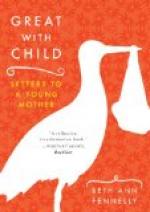In speaking of the structure of the room used for a nursery, I have adverted to the importance of having a large or double room, with sliding doors between, in order that the occupants may go into one of them, while the other is being ventilated. But whatever may be the structure of the room, the circumstances of the occupants, or the state of the weather, every nursery ought to be most thoroughly ventilated, once a day, at least; and when the weather is tolerable, twice a day. If there is but one apartment, and fear is entertained of the dampness of the fresh air introduced, or of currents, and if the mother and babe cannot retire, there is a last resort, which is for them to get into bed, and cover themselves a short time with the clothing. For though I have prohibited the covering of the face with the bed-clothes for any considerable length of time together, yet to do so for some fifteen or twenty minutes is an evil of far less magnitude than to suffer an apartment to remain without being ventilated, for twenty-four hours together—a very common occurrence.
When a lamp is kept burning in a nursery during the night, it should always be placed at the door of the stove, or in the chimney place, that its smoke, and the bad airs or gases which are formed, may escape. But it is better, in general, to avoid burning lamps or candles during the night. By means of common matches, a light may be produced, when necessary, almost instantly; especially if you have a spirit lamp in the nursery, or what is still better, one of spirit gas—that is, a mixture of alcohol and turpentine.
It is highly desirable that all washing, ironing, and cooking should be avoided in the nursery. They load the air with noxious effluvia or vapor, or with particles of dust; none of which ought ever to enter the delicate lungs of an infant.
Fumigations with camphor, vinegar, and other similar substances, have long been in reputation as a means of purifying the air in sick-rooms and nurseries; but they are of very little consequence. Fresh air, if it can be had, is always better.
CHAPTER IV.
THE CHILD’S DRESS
General principles. SEC. 1. Swathing the body—its numerous evils.—SEC. 2. Form of the dress. Fashion. Tight lacing—its dangers. Structure and motion of the chest. Diseases from tight lacing.—SEC. 3. Material of dress. Flannel—its uses. Cleanliness. Cotton—silk—linen.—SEC. 4. Quantity of dress. Power of habit. Anecdote. Begin right. Change. Dampness.—SEC. 5. Caps—their evils. Going bare-headed.—SEC. 6. Hats and bonnets.—SEC. 7. Covering for the feet. Stockings. Garters. Shoes—thick soles.—SEC. 8. Pins—their danger. Shocking anecdote.—SEC. 9. Remaining wet.—SEC. 10. Dress of boys. Tight jackets. Stocks and cravats. Boots.—SEC. 11. Dress of girls—should be loose. Temperature. Exposure to the night air.




